these are 6C33 tubes i ordered from Moscow, i am setting them up, burning in so to speak, these high transconductance tubes are prone to run-aways, so this burning-in is one way to mitigate such effects....filaments are wired in series for 12 volts and fed from a UPS transformer just discarded....the transformer has an unloaded voltage of 14volts......
since these tubes have been in storage for about 28 years(date code on the box says 1983), i found the pins are tarnished so that checking the filament continuity yielded an open circuit, scraping the pins by using fine grit sand paper restored contacts and confirmed thru the socket pins...
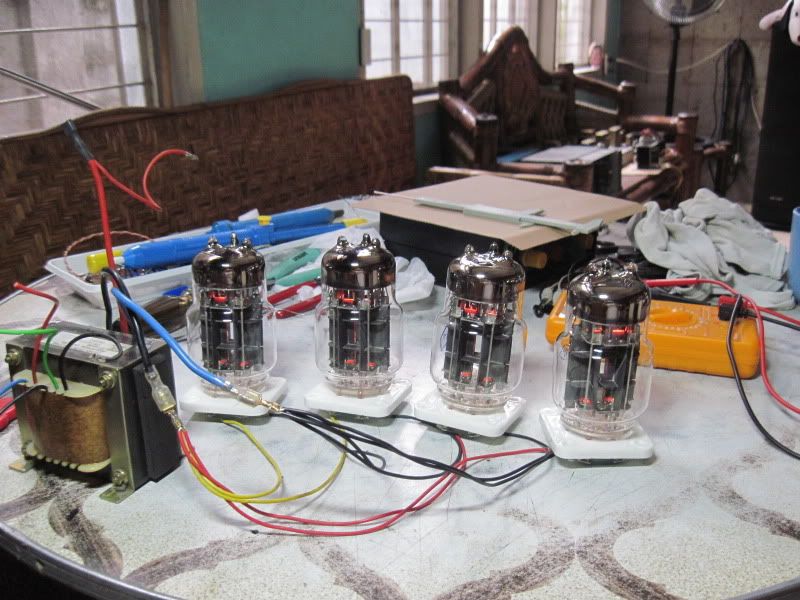
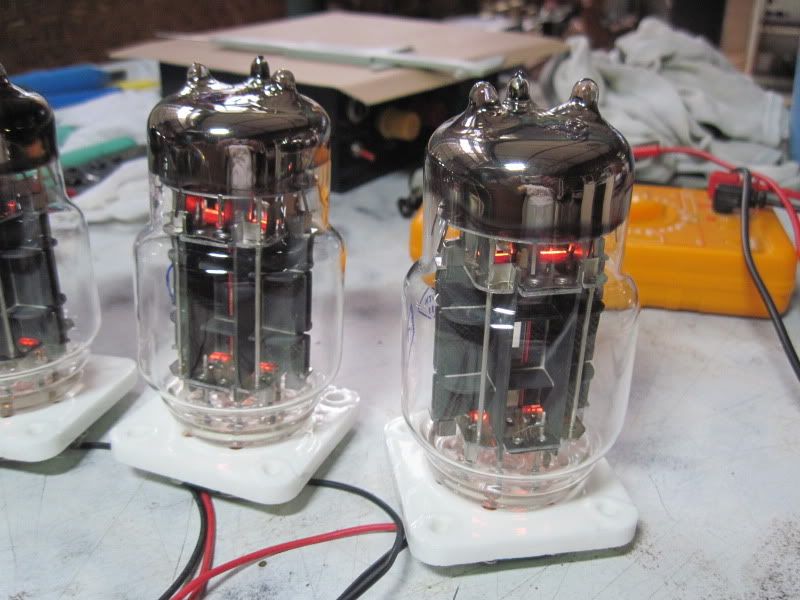
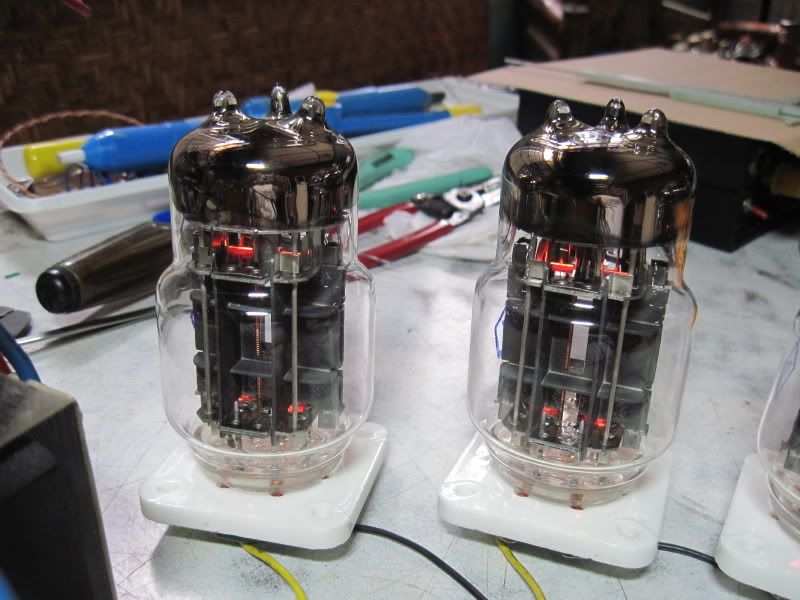
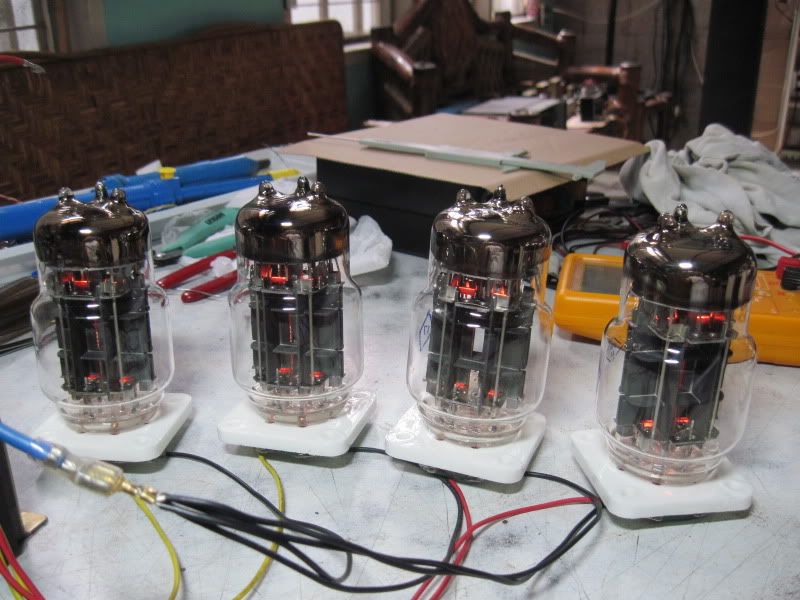
half an hour into the tests, i took some temperature readings:
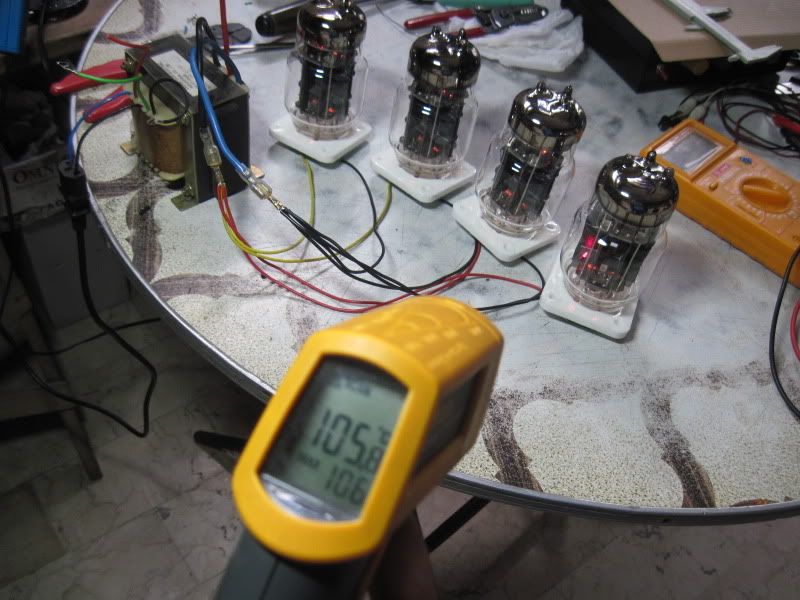
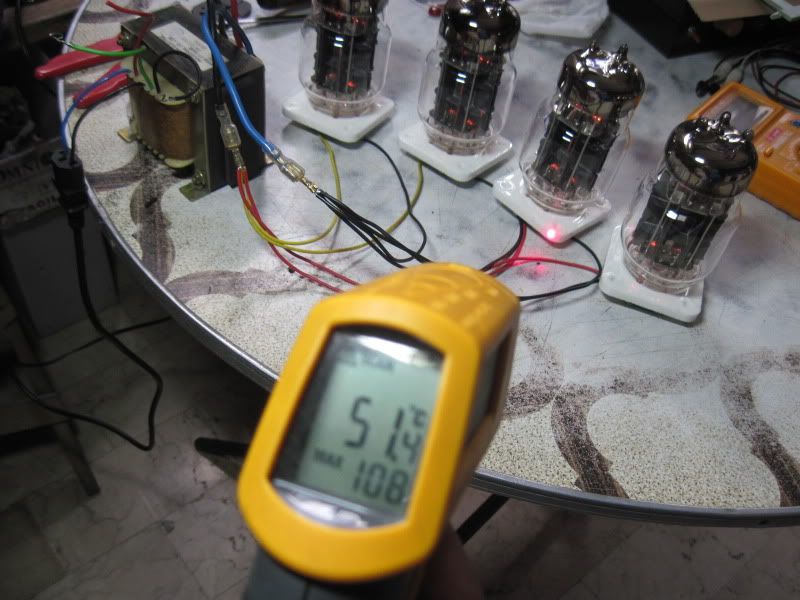
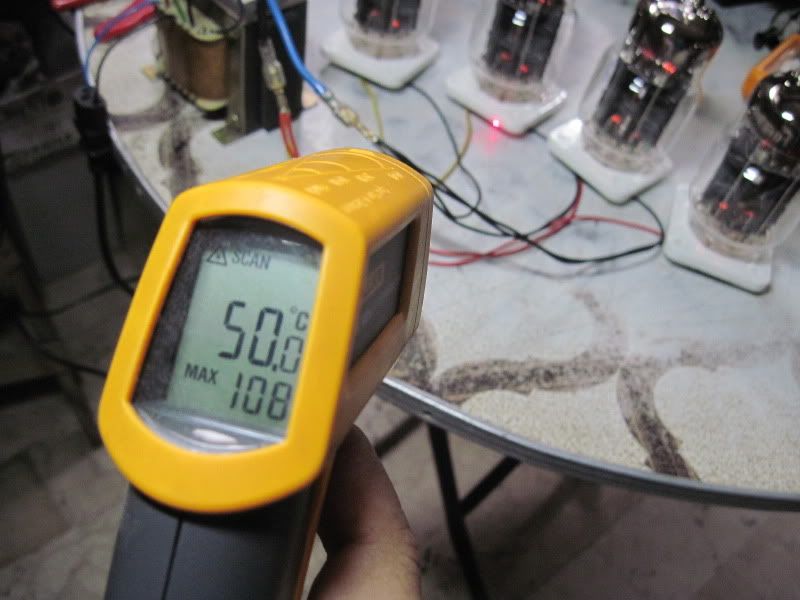
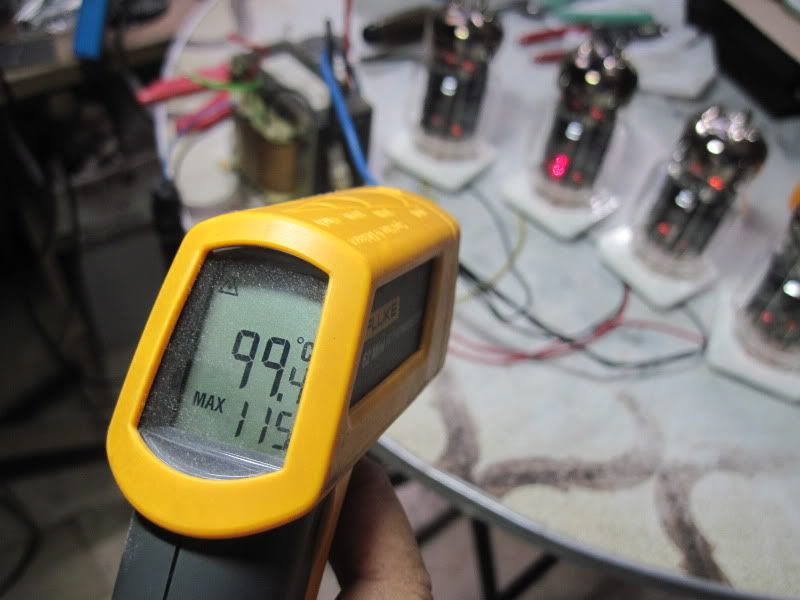
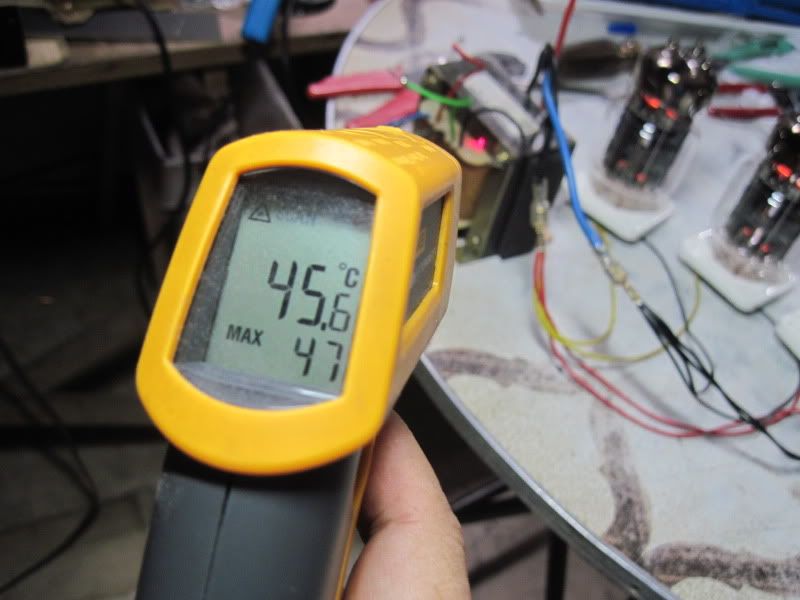
these reading increased further after 2 hours, i plan to burn-in the tubes for 24 hours in total before putting them in service.
the next part of the testing program is to monitor power consumption using a power monitor:
wattage in total:
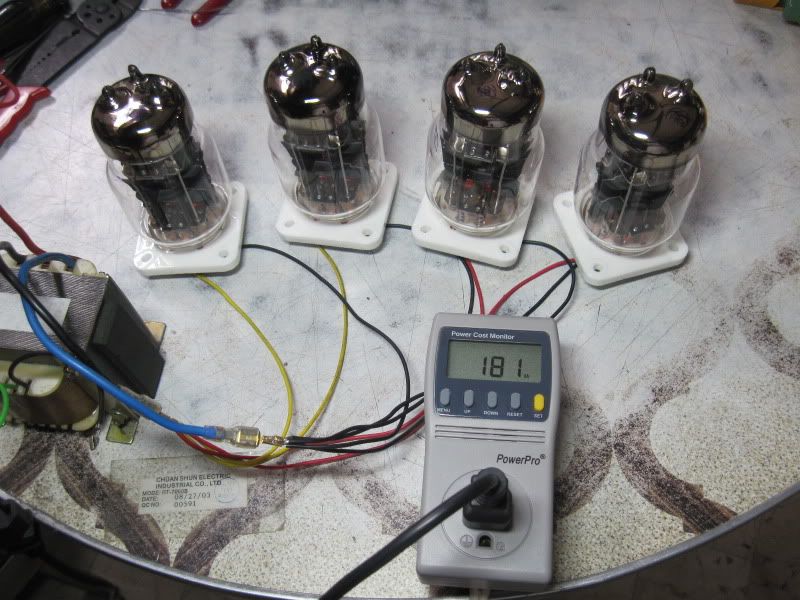
line frequency:
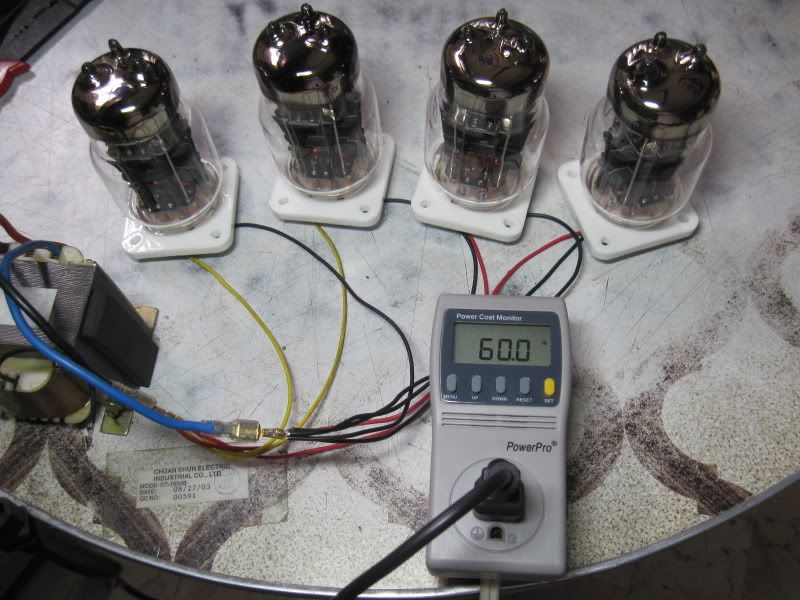
line voltage:
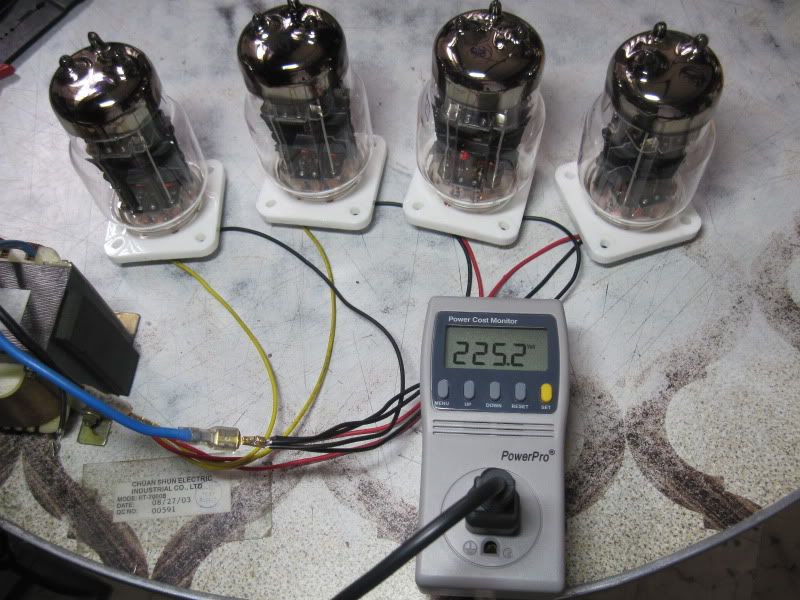
transformer primary current:
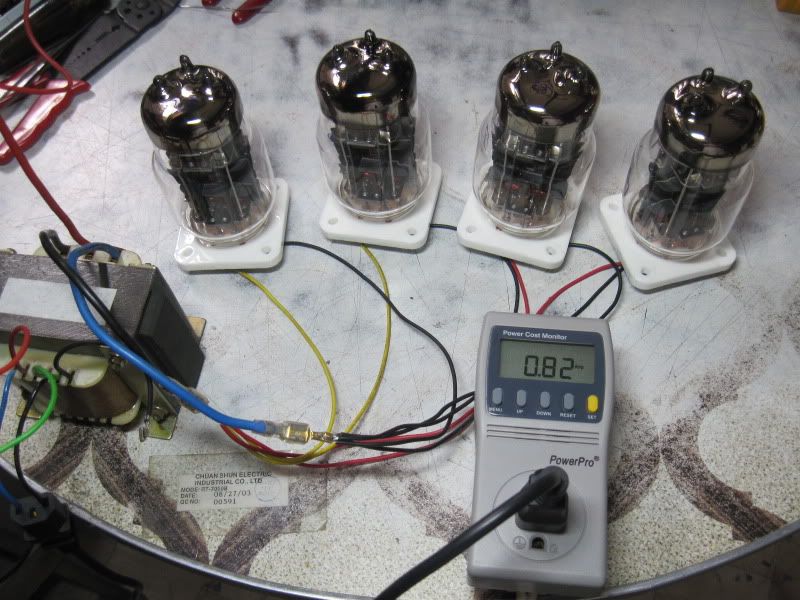
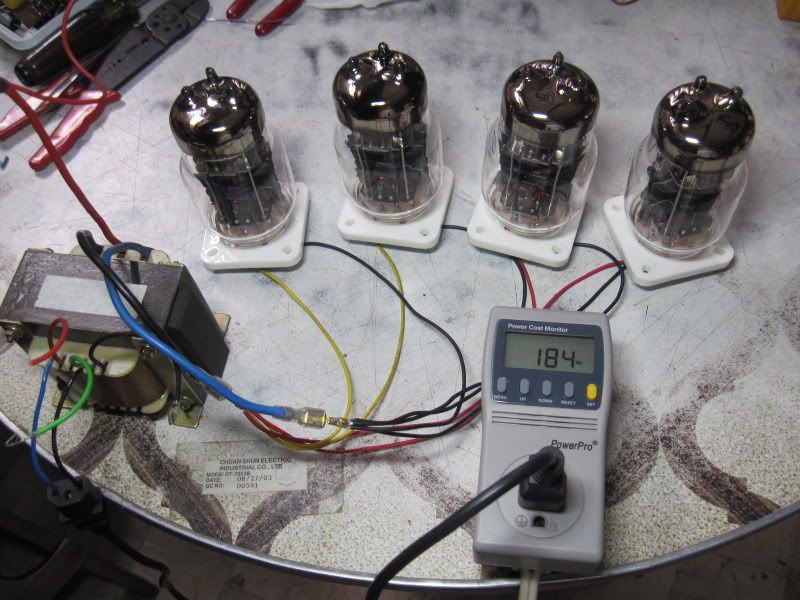
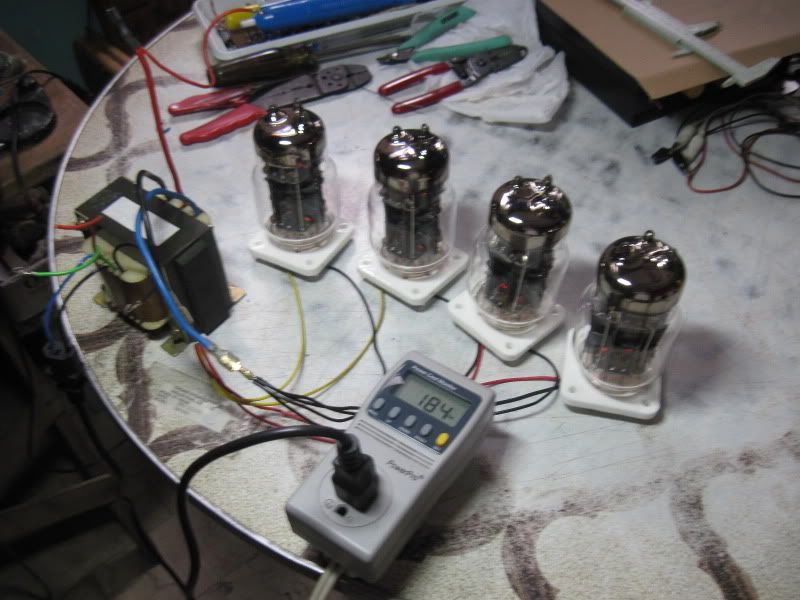
filament voltage:
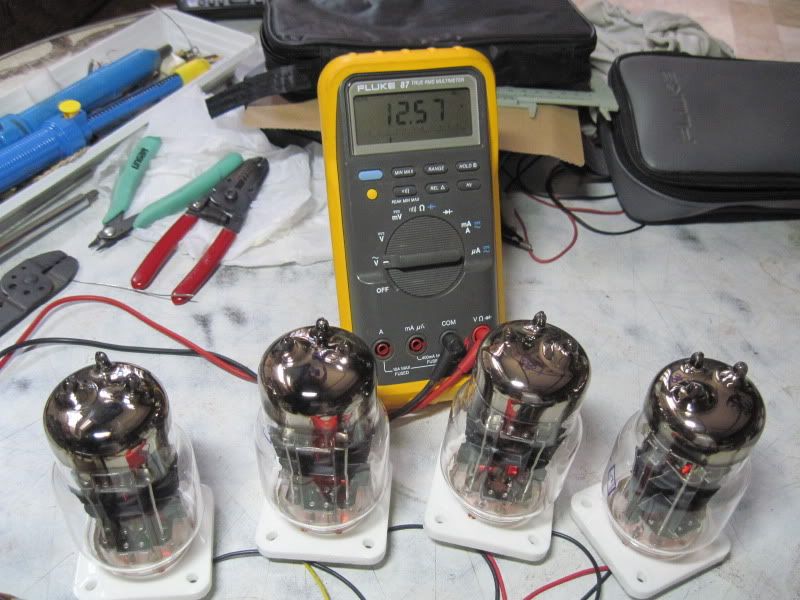
total filament current:
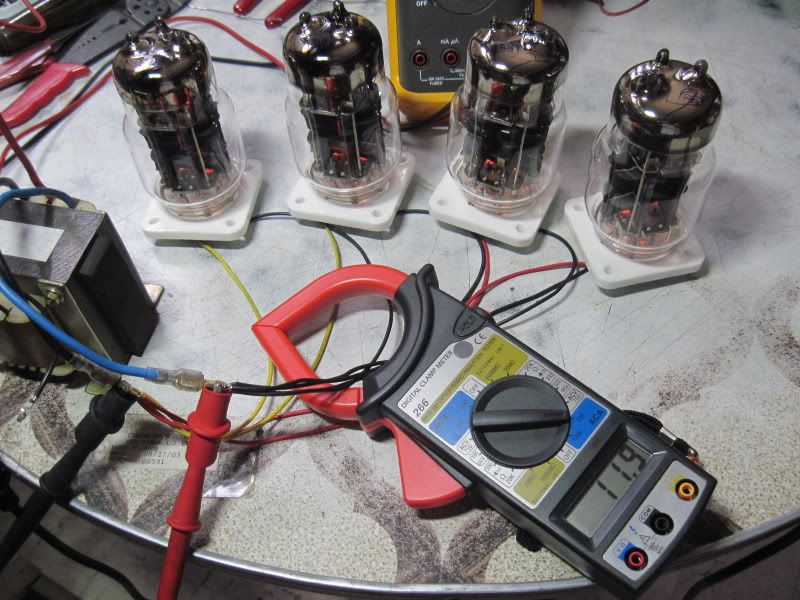
from the test data, of the 184 watts consumed, about 34 watts is lost in the transformer and the rest on the tube filaments.
these are really hot tubes.....
based on these results, design of the power transformer can then be undertaken.....
since these tubes have been in storage for about 28 years(date code on the box says 1983), i found the pins are tarnished so that checking the filament continuity yielded an open circuit, scraping the pins by using fine grit sand paper restored contacts and confirmed thru the socket pins...




half an hour into the tests, i took some temperature readings:





these reading increased further after 2 hours, i plan to burn-in the tubes for 24 hours in total before putting them in service.
the next part of the testing program is to monitor power consumption using a power monitor:
wattage in total:

line frequency:

line voltage:

transformer primary current:



filament voltage:

total filament current:

from the test data, of the 184 watts consumed, about 34 watts is lost in the transformer and the rest on the tube filaments.
these are really hot tubes.....
based on these results, design of the power transformer can then be undertaken.....
yup, i am making a push-pull amp....russian all the way....
6P15P driver, 6F12P input, probably like Wavebourn tower...undecided...
i am going to use grid chokes instead og grid leak resistors...
i am trying to get a feel of how hot the sockets are going to be under our 30*ambient temps.....
6P15P driver, 6F12P input, probably like Wavebourn tower...undecided...
i am going to use grid chokes instead og grid leak resistors...
i am trying to get a feel of how hot the sockets are going to be under our 30*ambient temps.....
with 2 tubes per channel you can get 30-ish watts per channel 😛 in SE. Why botter with PP 😀?
why not push-pull?😀
Dear Tony,these are 6C33 tubes i ordered from Moscow, i am setting them up, burning in so to speak, these high transconductance tubes are prone to run-aways, so this burning-in is one way to mitigate such effects....filaments are wired in series for 12 volts and fed from a UPS transformer just discarded....the transformer has an unloaded voltage of 14volts......
since these tubes have been in storage for about 28 years(date code on the box says 1983), i found the pins are tarnished so that checking the filament continuity yielded an open circuit, scraping the pins by using fine grit sand paper restored contacts and confirmed thru the socket pins...
these reading increased further after 2 hours, i plan to burn-in the tubes for 24 hours in total before putting them in service.
Thanks for post this topic, Iam in doubt right now about the 6C33 burning.
I need to burning some Svetlana 1969 and Iam complete newbie about it.
What exactly I have to watch??
In which case I must reject a 6C33??
These your tubes are Ulyanov and have full getter on the photos, I have 4 Svetlana and all 4 tubes have very few getter than this tubes in your photos.
Even one tube labeled X 69 OTK4 B*28n BbInyck XII -1969 r. have very few getter, and the head tube looks near transparent when puting a lamp light near the tube; This is normal??
A third tube labeled X 69 OTK4 B*28Л BbInyck XII -1969 r. have spots on the getter around the inside dual pins tips.
This is usual on the Svetlana tubes??
I thanks in advance for any input,
Gustavo
Last edited:
hi Gustavo,
this is my first venture into these tubes so i am not familiar with those Svetlana tubes you mentioned, my stocks, (i have 8 of them) seem to be dated 1983....
there are a lot of other 6C33 tube threads here, i suggest you go over them hopefully to answer your queries...
hope other members can chime in...
this is my first venture into these tubes so i am not familiar with those Svetlana tubes you mentioned, my stocks, (i have 8 of them) seem to be dated 1983....
there are a lot of other 6C33 tube threads here, i suggest you go over them hopefully to answer your queries...
hope other members can chime in...
Thanks Tony for your reply.
I say your tubes are Ulyanov why Svetlana factory stop 6C33 production in begin 70 years, and production go on at Ulyanov factory since then.
Regards, Gustavo
I say your tubes are Ulyanov why Svetlana factory stop 6C33 production in begin 70 years, and production go on at Ulyanov factory since then.
Regards, Gustavo
I saw some NOS 6C33C tubes have inner shorts. One developed short 0,5h after getting anode supply on. One had partial short, in form of lowered inner resistance. One had small bright glowing spot on grid, changing in rhythm of anode current. Better to use anode supply with current limiter for testing.What exactly I have to watch??
In which case I must reject a 6C33??
If the gitter is light, probably there is some air inside the tube.These your tubes are Ulyanov and have full getter on the photos, I have 4 Svetlana and all 4 tubes have very few getter than this tubes in your photos.
OTK means Quality Check Passed. Other info is just producing data. Avoid tubes produced from year end! From any year end (December). As in those times there was socialistic planning type economy, they had to fullfill plans to get bonuses and therefore all production made in year end was made in a hurry. This usually lead to quality somewhat lower. In the other hand all 6C33C tubes were made for military purposes, so producing quality is much higher than regular russian tubes have.Even one tube labeled X 69 OTK4 B*28n BbInyck XII -1969 r.
I saw such a phenomena on tubes being in use for some time, so probably those tubes are not NOS, but used.A third tube labeled X 69 OTK4 B*28Л BbInyck XII -1969 r. have spots on the getter around the inside dual pins tips.
If you only can, avoid using chinese crap sockets. Try to get sockets of this type. Those run much cooler, I measured only +45C at ab. +20C room temperature, if tubes are installed vertically upright and there circulates freely some air around sockets. No vents in amps!
After running heater only for 2h and anode supply 1h (3h all together) I consider tubes brake in done and have no problems with anode current stability using in amp with fixed bias. Of course there is a startup gap when using in amp: first there appers anode current somewhat lower and after 15-20 minutes it rises to adjusted for normal work value. Wonderful tubes, giving wonderful sound. I use them in OTL amp.
Last edited:
After running heater only for 2h and anode supply 1h (3h all together) I consider tubes brake in done and have no problems with anode current stability using in amp with fixed bias. Of course there is a startup gap when using in amp: first there appers anode current somewhat lower and after 15-20 minutes it rises to adjusted for normal work value. Wonderful tubes, giving wonderful sound.
@knoberik
can you elaborate? what is your supply voltage? did you use cathode resitors? thanks
My experiences are very similar to "knoberik" I also use 6C33C in OTL amps with fixed bias and in my amps I switch on heater first and then anode supply 90 seconds later, normally you see the current be lower at first before it stabilize after ~10 minutes. I burn in all tubes by heater only for 2 hours and then 250mA anode current for 2 hours. I have had 2 tubes, (out of >100) that didn't stabilize and one of them developed a grid cathode short but otherwise no problem with stability. Important to buy tubes from a reliable source as I heard stories about factory rejects being sold as NOS a some years back.
I have never experienced any current runaway with the 6C33C and can't see how that could happen, there is no mechanism in the tube that can make them runaway.
I have never experienced any current runaway with the 6C33C and can't see how that could happen, there is no mechanism in the tube that can make them runaway.
I have regulated power supply Oltronix LS135 for anode supply. It has 200mA current limiter (actually limiter kicks in at 220mA), giving up to 400V. My supply enables also regulated negative bias voltage 0...-300V needed for driving the tube. For heater I use separate transformer, from old TV set.what is your supply voltage? did you use cathode resitors? thanks
I had used 160V@200mA for brake in, giving 32W dissipation on anode. For measuring purposes I use 0,1 ohm cathode resistor, as I just have those. Therefore 1mV = 10mA. My testing circuit.
It is possible also to use 1 ohm cathode resistor, in this case there will be 1mV = 1mA.
It is possible to get the 6C33C into thermal runaway, but you have to do some things wrong first. If the anode current will be set for cold tube right up to the value, suitable for hot tube, in this case it will go into thermal runaway. Those thick anode tubes (also older sister 6C18C and little brother 6C41C) are not ment to be run nearby anode red glow currents. Overheating will bend those anodes and it will spoil the tube at once. It is essential to keep on mind the startup current gap. When this concearn is covered, there seems no problems about anode current runaway for 6C33C.I have never experienced any current runaway with the 6C33C and can't see how that could happen, there is no mechanism in the tube that can make them runaway.
And forget output transformers when using 6C33C. This tube do not need output transformer for getting 15-20W. And OTL amp with schematics originally created by "tubetvr" sounds just excellent!
Last edited:
I have regulated power supply Oltronix LS135 for anode supply. It has 200mA current limiter (actually limiter kicks in at 220mA), giving up to 400V. My supply enables also regulated negative bias voltage 0...-300V needed for driving the tube. For heater I use separate transformer, from old TV set.
I had used 160V@200mA for brake in, giving 32W dissipation on anode. For measuring purposes I use 0,1 ohm cathode resistor, as I just have those. Therefore 1mV = 10mA. My testing circuit.
It is possible also to use 1 ohm cathode resistor, in this case there will be 1mV = 1mA.
thanks a lot....
If the anode current will be set for cold tube right up to the value, suitable for hot tube, in this case it will go into thermal runaway.
It depends on what the current is, if the tube "cold" is set to 200mA it never happens, (from what I have found) but it could probably happen if the cold tube is set for a much higher current close to maximum recommended 600mA.
With 200mA starting current the tube stabilise on a higher current maybe ~250mA or so but not much higher.
Disclaimer: what I mean with cold condition is when the heater has been preheated 90 seconds, I never run 6C33C without preheating as there is too big risk of tube failure in the case that e.g. grid voltage comes on slightly later than anode voltage, with 160V anode voltage the tube is capable of passing 3.5A so it can selfdestruct quickly if something go wrong.
The catasthrophic failure, (if it happens) doesn't seem to be related to moderatly excessive anode dissipation either, I have several times been running 6C33C for extended time, (hours) with a large part of the anode area glowing red, (this happens when anode dissipation is a bit more than 60W) but with no ill effects.
My theory is that failure happens when the anode heats the grid so much that the grid get soft and fall back towards the cathode, when the cathode grid distance is reduced the anode current is further increased and the process continues until total failure. This doesn't happen at 60W anode dissipation from my experience but could probably happen when higher. An easy way to destroy a 6C33C is to tie the grid to the cathode and connect the tube to heater and anode voltage, it will then self destruct in a few seconds with a flash seen in the grid cathode area.
However, nothing of what I have described happens when the tube is used under controlled conditions and within specs so I think it is exaggerated to talk about a risk of runaway
Dear Knoberik,I saw some NOS 6C33C tubes have inner shorts.....
Very thanks for your guidance and recommendations I greatly appreciated it.
I noted my Svetlana have better leads contact/solder inside, than the Ulyanov ones.
The low getter tube I mention have a dark getter, so it is OK apparently, the tube are new, with a gray paint in the pins yet.
I wonder If there is any advantage in the Svetlana over the regular Ulyanov??
It have better sound than the Ulyanov??
It lasts more than the Ulyanov?? etc...
Thanks, Gustavo
The case is Svetlana factory has a bit better reputation than other russian tube factories. For what reason - I'm not sure about... Urban myth? I myself ran into problems mainly with Svetlana factory 6C33C's. And I do not believe there is significant differences in sound between products from different factories. Production in soviet factories was unified very long way. Older ones I saw were from 1966, and newest are from 1991. Both look similar, no visible differences nor in sound.I wonder If there is any advantage in the Svetlana over the regular Ulyanov??
It have better sound than the Ulyanov??
It lasts more than the Ulyanov?? etc...
What's about the 6C33C tubes from different factories: I think all of them are quite ok as those were made for military use only. No civilian version at all. It means very strong quality control on all factories who produced those tubes. Of course they had better tubes selected for military aircraft use and a bit easier standards for others. Nowadays nobody really can separate those versions from each other. Usually russian old NOS tubes, ment for military use have suffix -B (russian letter V). For example 6C33C-B. But I emphasize: all of 6C33C are originally ment for military use only, even those without -B.
Just try to find tubes for matched pairs with similar bias voltage at given anode current. This will be well enough for selecting.
Last edited:
- Status
- Not open for further replies.
- Home
- Amplifiers
- Tubes / Valves
- 6C33